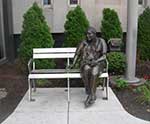Check out these unique destinations that reflect the genuine character of our region.
East Troy Railroad Museum
2002 Church St., East Troy, Wis., (262) 642-3263, easttroyrr.org
The East Troy Railroad Museum is the perfect place for rail enthusiasts.
The museum offers historical information, realistic model railroad layouts, and artifacts and schedules from the interurban railroad days.
“We hope to provide a hands-on experience for children and adults who will learn what it was like to travel by rail in the late 1800s through the 1940s,” says Steve Thomas, a museum volunteer.
The museum, housed in a remodeled 1910 substation, is operated entirely by volunteers.
Along a well-maintained 10-mile track from East Troy to Mukwonago, Wis., the museum operates a collection of historical rail cars.
“We run railroad cars that are 90 to 100 years old, providing a rare glimpse of actual history in operation,” Thomas says.
The train travels to Mukwonago every Friday, Saturday and Sunday for scheduled round-trip journeys and occasional special excursions, including those for Christmas, pizza and special dinners.
“We are an all-electric railroad, using overhead catenary to power the interurban cars and trolleys,” Thomas says. “We are the only all-electric railroad offering regularly scheduled dining car service in North America.”
Museum admission is free. Tickets to ride the trains round-trip to Mukwonago are $8 for children 3 to 14 and $12.50 for adults. Children 2 and under are free.
Museum is open Sat.-Sun. 9:30 a.m.-4 p.m. from April 22 through mid-December and Fridays from 10 a.m.-2 p.m. in June, July and August.
Grace Farm Studios
2719 Franklinville Road, Woodstock, (815) 790-8895, gracefarmstudios.com
Located in the open countryside between Woodstock and Marengo, this family farm uses every acre to great effect.
The 3-acre you-pick farm sells red, yellow, purple and black raspberries.
Grown using organic farming practices, the raspberries are trellised inside Haygrove high tunnels, a method seen in the United Kingdom. The steel and plastic tarp-covered structures allow raspberries to grow regardless of weather conditions.
Owners and operators Mike Owney and Ann Chaney, also grow gooseberries, black and red aronia berries, red currants, serviceberries, elderberries, lingonberries, hazelnuts and native wildflowers.
Wool harvested from Icelandic sheep pastured on the farm and Holliberri Icelandics in Elizabeth, Ill., is also sold on-site. The processed wool is sold in felt, roving and yarn forms.
Inside the farmstand, visitors can find rustic decorative art, including stoneware, Icelandic wool wall hangings, wool baskets and furnishings crafted from locally harvested hardwoods.
Plantings of native grasses, forbs, shrubs and trees make the farm look like a slice of authentic northern Illinois prairie. Summertime visitors are sure to see and hear native and migratory birds and small wildlife that make their home on the land.
Hours: Mon.-Sat. 8 a.m.-5 p.m.
Aurora Public Sculpture Tour
Various Locations, Aurora, (630) 256-3340, aurora-il.org/publicarts
The Aurora Public Art Commission (APAC) uses sculptures to connect with the public.
“Aurora has long been committed to the presentation of public art in all its forms,” says Rena Church, director of public arts for APAC. “Sculptures make an area more interesting and somehow more human and accessible. A great sculpture grabs the attention and makes people linger, wonder and enjoy.”
Seven sculptures are spread out around downtown Aurora, each with its own significance.
The bronze Marie Wilkinson sculpture, created by artist Preston Jackson and unveiled in 2008, sits near Paramount Theatre. Wilkinson was an Aurora resident and local civil rights activist.
“The sculpture is of her sitting on a bench and patting it,” Church says. “When people see that sculpture, they know who she is.”
Artist Christian Tobin created “Swimming Stones,” a kinetic, interactive sculpture and fountain at the corner of Stolp Avenue and Benton Street.
The granite statue, unveiled in 2001, demonstrates the power of water pressure by orchestrating controlled water movement around massive granite stones.
“The Mastodon Dig” is a bronze sculpture created by Erik Blome, a Crystal Lake native. This sculpture, located near the visitors center at Phillips Park, depicts a Civil Works Administration (CWA) worker digging up a mastodon bone. Commissioned in 2004, the sculpture recognizes the 1934 discovery of several mastodon bones as CWA workers dug up the basin for the Phillips Park Lake.
Other Aurora sculptures include “The Fireman,” located at the Aurora Regional Fire Museum; “The Bears And Animal Reliefs,” located at the Phillips Park Zoo; “The Journeyman,” located at the Aurora Transportation Center and “City Lights/City Life,” located in the park next to Paramount Theatre.




















































